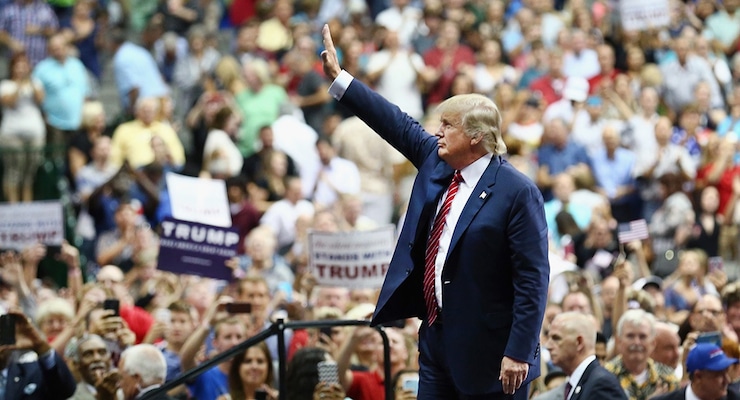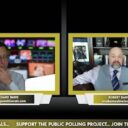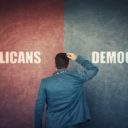

DALLAS, TX – SEPTEMBER 14: Republican presidential candidate Donald Trump greets supporters during a campaign rally at the American Airlines Center on September 14, 2015 in Dallas, Texas. More than 20,000 tickets had been distributed for the event. (Photo by Tom Pennington/Getty Images)
I’m very happy that we don’t have a one-world government, but my views have nothing to do with conspiratorial fears involving blue helmets and black helicopters.
Instead, I’m happy that there are lots of independent nations because that means lots of different approaches to public policy. And that means we have lots of real-life experiments about the relative merits of big government vs small government.
And this brings me joy because the evidence overwhelmingly shows that you get much better results when the size and scope of government is constrained.
Just compare France and Switzerland. Or look at the wreckage of communism. Or consider the prosperity of Hong Kong and Singapore.
Heck, I’ve put together all sorts of long-run comparisons to show that free markets produce much better results than statism.
This is also why I like federalism inside a nation. I think this decentralized approach leads to better policy, as we can see from Switzerland.
But it also means I have another set of real-life experiments about public policy. And, once again, this brings a smile to my face because the data clearly show the negative consequences of big government.
It’s especially amusing to compare California and Texas.  The Golden State is a playground for statist policies, including the highest income tax in the nation. The Lone Star State, by contrast, is famous for its laissez-faire approach and it doesn’t have any income tax.
The Golden State is a playground for statist policies, including the highest income tax in the nation. The Lone Star State, by contrast, is famous for its laissez-faire approach and it doesn’t have any income tax.
And if you look at income data, we have very clear evidence that living standards are climbing much faster in Texas, particularly for the middle class.
I’m certainly not the only person to notice that there’s a clear link between good policy and good results.
Writing for Investor’s Business Daily, Vance Ginn of the Texas Public Policy Foundation compares Texas and California. He starts by noting that the Lone Star State and the Golden State share some common characteristics.
Texas and California…contribute 25% of U.S. economic output, have similar abundances of natural resources, and are where 20% of Americans reside.
But that’s where the similarity ends. California almost surely wins the battle for which state has the best climate and scenery, but Texas is way ahead when you measure economic freedom.
Texas has low taxes, no personal income tax, and less regulation, versus California’s high taxes, highest marginal personal income tax rate nationwide, and burdensome regulations. The Economic Freedom of North America report…ranks Texas as the third most free state and California as second worst. The Tax Foundation ranks Texas as having the 14th best business tax climate while California ranks third worst.
Vance then addresses the left-wing stereotype that Texas is a poverty-stricken backwater.
He looks at various measures and finds that Texas always comes out on top. There’s more poverty in California.
What about poverty? Taking the average over the 2013 to 2015 period, the Census Bureau provides the official poverty rate of 16.1% in Texas and 15% in California, which suggests that the critics are right. However, that rate doesn’t account for regional differences in housing costs or noncash government assistance. The supplemental poverty rate includes these factors and instead finds a rate of 14.9% in Texas while California has the highest rate nationwide at 20.6%.
But there’s more income in Texas.
What about real income? Average nominal median household income from 2010 to 2014 (in 2014 dollars) in California ($61,489) is 17% higher and nationwide ($53,482) is 1.7% higher than in Texas ($52,576). But, the Bureau of Economic Analysis’ regional price parities data for 2014 show that the cost of living for California is 17% higher and the U.S. average is 3.5% higher than in Texas. Therefore, real income in Texas purchases as much as in California and even more when you consider that Texas doesn’t have a personal income tax.
Vance then points out that there is more income inequality in California, which I generally think is an irrelevant measure.
In this case, though, it probably does matter because bad policy is causing disproportionate harm for the poor and middle class in California.
The column also looks at the jobs data (which will cause special angst for Paul Krugman).
In the last decade, Texas has been the economic and job creation engine as the real private sector expanded 29% in Texas compared with only 14% in California. Moreover, total civilian employment increased 1.2 million in California but 1.7 million in Texas, with a labor force two-thirds the size of California’s. This increase in Texas’ employment accounts for nearly one-third of all jobs created nationwide.
So what’s the moral of the story?
Vance closes his column with some very appropriate advice for the incoming Trump Administration.
The more you tax and regulate something, the less you get of it. Clearly, less government contributes to higher standards of living in Texas. …As the new administration and policymakers nationwide reassess which direction to take, it’s important to remember that spending is the disease and taxes are a function of that disease. Restraining spending growth while following the Texas model of free market capitalism would be an excellent way to get the economy, and personal finances, back on track.
None of this means policy is perfect in Texas, needless to say. There are several ways that policy could be improved.
But if you’re looking for general lessons about the relative merits of big government vs. small government, both Texas and California are role models. They teach us lessons about job creation. About business climate. About government efficiency. And about labor mobility. And the lesson is always the same: You get better results when government is smaller and less intrusive.







President Trump / November 23, 2016
Please elaborate on this claim I see WI total votes Trump outperformed Romney by 2K votes 3rd party… https://t.co/mRxv9c421P
/
JacksonPackson / November 23, 2016
@PPDNews Thoughts on this recount BS? Heard PA was REALLY hard to get a recount going (court has to file etc) Can u confirm?
/
Fugitiveinhiding / November 24, 2016
@Julia_Gulia_1 @danieljmitchell Cutting a swathe through the morass of rotten swamp bramble..
/